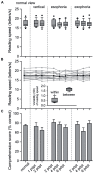Reading performance is not affected by a prism induced increase of horizontal and vertical vergence demand
- PMID: 24987346
- PMCID: PMC4060573
- DOI: 10.3389/fnhum.2014.00431
Reading performance is not affected by a prism induced increase of horizontal and vertical vergence demand
Abstract
Purpose: Dyslexia is the most common developmental reading disorder that affects language skills. Latent strabismus (heterophoria) has been suspected to be causally involved. Even though phoria correction in dyslexic children is commonly applied, the evidence in support of a benefit is poor. In order to provide experimental evidence on this issue, we simulated phoria in healthy readers by modifying the vergence tone required to maintain binocular alignment.
Methods: Vergence tone was altered with prisms that were placed in front of one eye in 16 healthy subjects to induce exophoria, esophoria, or vertical phoria. Subjects were to read one paragraph for each condition, from which reading speed was determined. Text comprehension was tested with a forced multiple choice test. Eye movements were recorded during reading and subsequently analyzed for saccadic amplitudes, saccades per 10 letters, percentage of regressive (backward) saccades, average fixation duration, first fixation duration on a word, and gaze duration.
Results: Acute change of horizontal and vertical vergence tone does neither significantly affect reading performance nor reading associated eye movements.
Conclusion: Prisms in healthy subjects fail to induce a significant change of reading performance. This finding is not compatible with a role of phoria in dyslexia. Our results contrast the proposal for correcting small angle heterophorias in dyslexic children.
Keywords: dyslexia; phoria; reading; strabismus; vergence.
Figures


Similar articles
-
Gaze-dependent phoria and vergence adaptation.J Vis. 2016;16(3):2. doi: 10.1167/16.3.2. J Vis. 2016. PMID: 26830708
-
Dyslexic children are confronted with unstable binocular fixation while reading.PLoS One. 2011 Apr 6;6(4):e18694. doi: 10.1371/journal.pone.0018694. PLoS One. 2011. PMID: 21494641 Free PMC article.
-
Differential diagnosis of vergence and saccade disorders in dyslexia.Sci Rep. 2020 Dec 17;10(1):22116. doi: 10.1038/s41598-020-79089-1. Sci Rep. 2020. PMID: 33335200 Free PMC article.
-
Visual training could be useful for improving reading capabilities in dyslexia.Appl Neuropsychol Child. 2021 Jul-Sep;10(3):199-208. doi: 10.1080/21622965.2019.1646649. Epub 2019 Aug 13. Appl Neuropsychol Child. 2021. PMID: 31407599 Review.
-
[Prism correction in heterophoria].Ophthalmologe. 2002 Jan;99(1):3-9. doi: 10.1007/pl00007112. Ophthalmologe. 2002. PMID: 11840793 Review. German.
Cited by
-
Do standard optometric measures predict binocular coordination during reading?J Eye Mov Res. 2021 Jan 21;13(6):10.16910/jemr.13.6.6. doi: 10.16910/jemr.13.6.6. J Eye Mov Res. 2021. PMID: 33828816 Free PMC article.
-
Visual function deficits in dyslexic children: a case-control study.BMC Ophthalmol. 2025 Mar 18;25(1):144. doi: 10.1186/s12886-025-03959-3. BMC Ophthalmol. 2025. PMID: 40102786 Free PMC article.
-
Binocular advantages in reading revisited: attenuating effects of individual horizontal heterophoria.J Eye Mov Res. 2019 Dec 9;12(4):10.16910/jemr.12.4.10. doi: 10.16910/jemr.12.4.10. J Eye Mov Res. 2019. PMID: 33828742 Free PMC article.
-
Nystagmus Does Not Limit Reading Ability in Albinism.PLoS One. 2016 Jul 8;11(7):e0158815. doi: 10.1371/journal.pone.0158815. eCollection 2016. PLoS One. 2016. PMID: 27391149 Free PMC article. Clinical Trial.
-
The relation between the severity of reading disorder and visual functions among children with dyslexia.Taiwan J Ophthalmol. 2021 Oct 29;12(2):178-183. doi: 10.4103/tjo.tjo_33_21. eCollection 2022 Apr-Jun. Taiwan J Ophthalmol. 2021. PMID: 35813801 Free PMC article.
References
-
- Canetti E. (1980). Die Blendung, 4th Edn. Munich: Carl Hanser Verlag
-
- Cassin B. (1975). Strabismus and learning disabilities. Am. Orthopt. J. 25 38–45 - PubMed
LinkOut - more resources
Full Text Sources
Other Literature Sources

